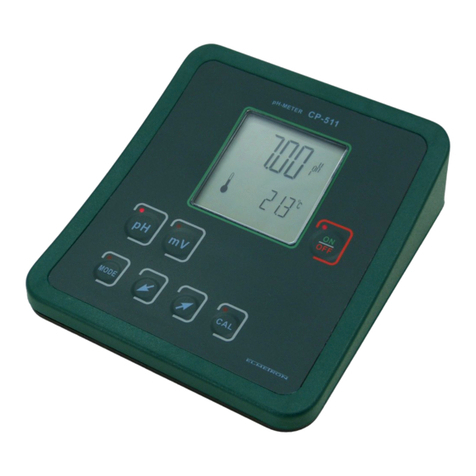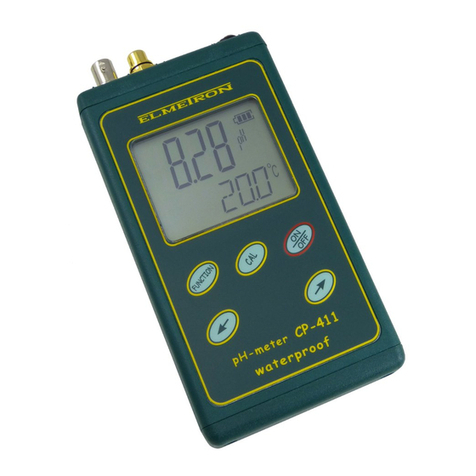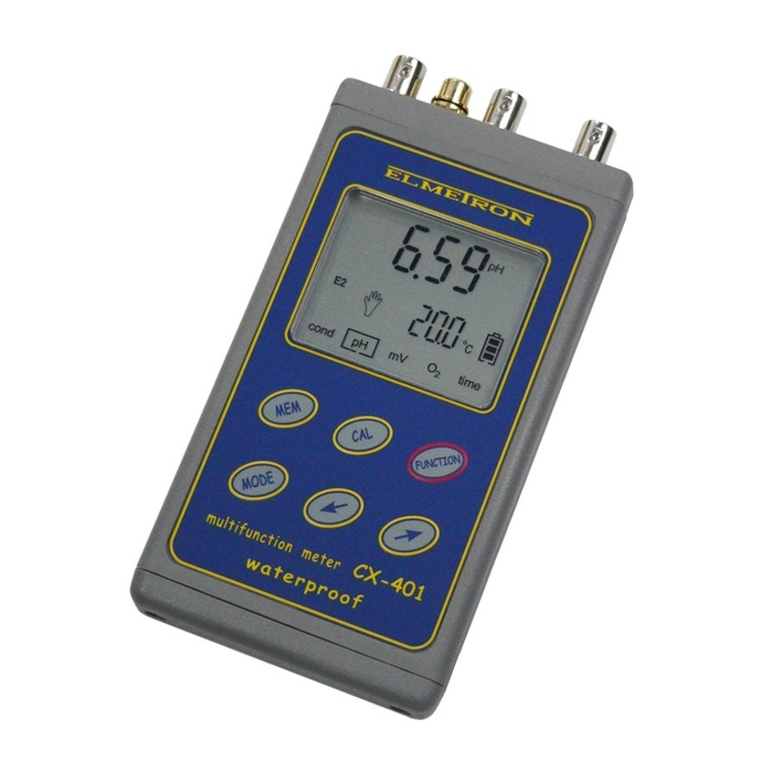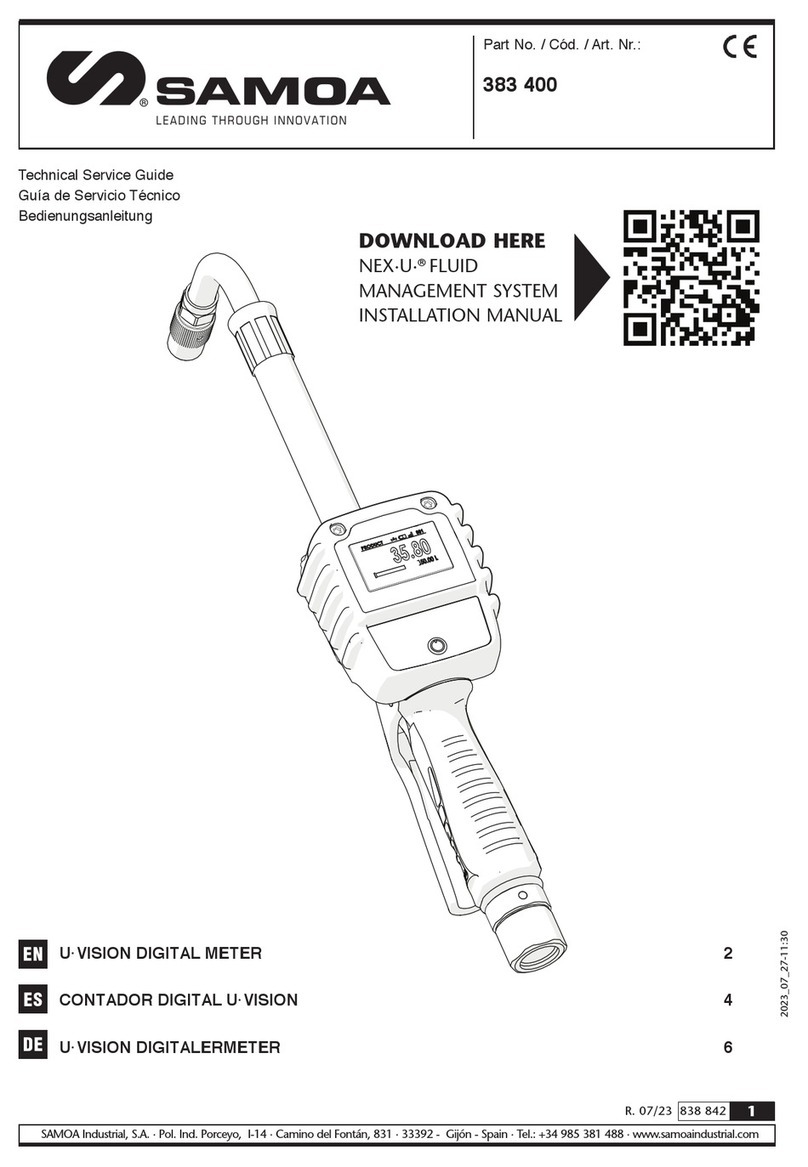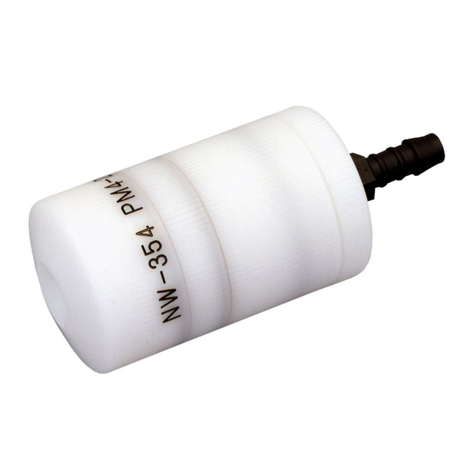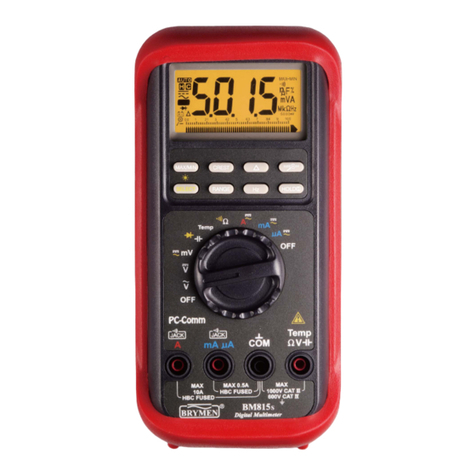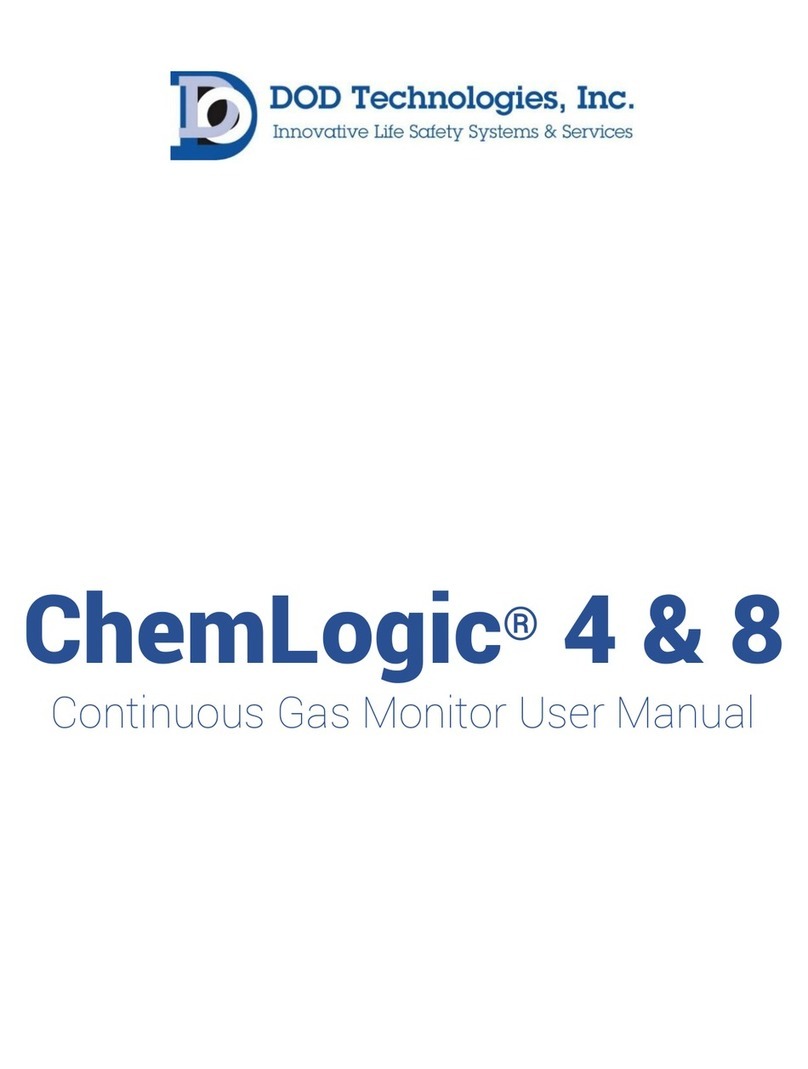ELMETRON CX-461 User manual

WATERPROOF
MULTIFUNCTION
METER
CX-461
USER‘S MANUAL


USER‘S MANUAL
WATERPROOF
MULTIFUNCTION METER
CX-461
Read the instructions carefully before use


CONTENTS
I. INTRODUCTION 1
1.Exploitation notices 3
2.Characteristics of the meter 4
3.The meter‘s use 5
4.The outside view 6
5.The meter‘s maintenance 8
6.Switching the meter on and off 9
6.1.Choosing the measurement function 10
7.Preparation to work 11
7.1.Choosing the kind of the temperature compensation 11
II. pH MEASUREMENT 13
8.Preparation of the pH electrode 15
9.Setting the pH measurement parameters 16
9.1.Resolution 16
9.2.Electrode number 17
9.3.Calibration solution 18
9.4.Calibration points and date 18
9.5.Calibration validity date 18
10. Calibration 19
10.1. Calibration in buffer or standard solutions 20
10.2. Entering the buffers’ values into the meter’s memory 21
10.3. Calibration in buffer solutions 23
10.4. Calibration with use of standard solutions 24
11. Checking the electrode condition 26
12. pH measurement 27
12.1. Measurement with automatic temperature compensation 27
12.2. Measurement with manual temperature compensation 28
13. Notices about the temperature compensation and interpretation of the pH
measurement results 29
III. CONDUCTIVITY AND SALINITY MEASUREMENT 31
14. Basic information about conductivity measurement 33
15. Entering the conductivity parameters 34
15.1. Resolution 34
15.2. Cell number 35
15.3. Choosing the unit 35
15.4. Calibration points and date 36
15.5. Calibration validity time 36
15.6. Entering the αcoefficient 36
15.7. Entering the reference temperature 37
15.8. Entering the W
TDS
coefficient 37
16. Choosing and maintaining the conductivity cell 38
16.1. Choosing the cell 38
16.2. Maintenance of the cell 39
17. Calibration 40
17.1. Calibration without standard solution 40
17.2. Calibration with use of standard solution 41
18. Conductivity measurement 45
18.1. Measurement without temperature compensation 45
18.2. Measurement with automatic temperature compensation 46
18.3. Measurement with manual temperature compensation 47

19. Salinity and total dissolved solids measurement 48
19.1. Salinity measurement with conversion to NaCl or KCl 49
19.2. Determining the W
TDS
coefficient 50
19.3. The salinity measurement with conversion to TDS 50
20. Simplified way of determining the αcoefficient 51
IV. OXYGEN CONCENTRATION MEASUREMENT 53
21. Basic information about the oxygen measurement 55
22. Entering dissolved oxygen measurement parameters 57
22.1. Resolution 57
22.2. Sensor number 57
22.3. Unit 58
22.4. Calibration points and date 58
22.5. Calibration validity time 58
22.6. The salinity influence compensation 58
22.7. Automatic compensation of the atmospheric pressure influence 59
23. Calibration of the dissolved oxygen sensor 60
24. Measurement of oxygen concentration in water 62
24.1. Measurement with automatic temperature compensation 62
24.2. Measurement with manual temperature compensation 63
25. Measurement of oxygen content in air 64
V. ATMOSPHERIC PRESSURE MEASUREMENT 65
26. Atmospheric pressure measurement 67
VI. REDOX POTENTIAL (MV) AND TEMPERATURE MEASUREMENT 69
27. Setting the redox potential parameters 71
27.1. Resolution 71
27.2. Relative measurement 72
27.3. Reference voltage 72
28. redox potential measurement 73
29. Setting the temperature measurement parameters 74
29.1. Resolution 74
29.2. Probe number 75
29.3. Sensor group 75
29.4. Unit 75
29.5. Temperature of the manual compensation 75
30. Temperature measurement 76
VII. OPTIONS 77
31. Options screen 79
31.1. Functions 79
31.2. Series 80
31.3. Miscellaneous 80
31.4. Info 82
32. Recording the readings, memory readout 83
32.1. Storage parameters 83
32.2. Entering single readouts into the memory 85
32.3. Collecting measurement series 86
32.4. Reviewing the readouts 87
33. Power, replacing the rechargeable batteries 88
34. Cooperation with PC 89
35. Technical data 90
36. Equipment 93

- 1 -
I. INTRODUCTION

- 2 -
User‘s manual for CX-461 multifunction meter v1.40

- 3 -
1. EXPLOITATION NOTICES
Dear User!
We present you a device distinguished by accuracy according to the
technical data and by a high stability of the displayed results. We believe that
the measurements would not cause you any trouble and that the meter would
operate without any inconvenience. Wide range of additional functions
requires careful reading of the manual, in other case some of the
features may stay unused or using the meter may be troublesome.
Using electrodes of good quality and replacing them after a suitable time
ensures obtaining high measuring accuracy. It is worth remembering that
electrodes have much shorter lifespan than the meter. Deterioration of the
result stability and increase of the measuring error are typical symptoms of
an improper work of the electrode. Some problems users have may arise
from using pH electrodes not being conditioned before the
measurement, making measurements not having removed the shielding
ring from the liquid junction, with contaminated membrane or plugged
junction. To avoid such situations it is necessary to choose a kind of
electrode suitable for solutions which are going to be measured, e.g.,
sewage, liquids with deposits, meat, cheese etc. Therefore, if you observe
improper operation of the device, please take control measurements with
another electrode. In most cases deterioration of the meter’s work is
caused by the electrode and not by the meter itself.
In case of conductivity measurements it is important to choose the cell with
a K constant value suitable for the measuring range. Improper selection may
cause larger error occurrence, what may also happen during measurements
with automatic temperature compensation with an inappropriate α
αα
αcoefficient
introduced.
Accuracy of the dissolved oxygen measurements depends on the sensor’s
calibration and regular conservation which consists in replacing the
membranes, electrolyte and cleaning the electrodes. Neglecting these
activities after some time would make measurements impossible.
Please turn your attention to the fact that stabile measurement is
possible only with natural or simulated water flow.
The essential feature of our products is their low failure frequency. However,
in case of the meter’s failure, our firm provides its immediate repair under the
warranty conditions.
We wish a pleasant and trouble-free work with our meter.

- 4 -
User‘s manual for CX-461 multifunction meter v1.40
2. CHARACTERISTICS OF THE METER
CX-461 multifunction meter belongs to the newest generation of measuring
devices. It offers wide range of additional functions. The meter ensures high
accuracy and repeatability of readings. Two kinds of power source: the
rechargeable battery and the power adapter, enable work in field and long-
lasting measurements in the laboratory. The meter’s memory is independent
from power supply. The meter is equipped with a large backlit custom LCD,
which can display readouts of four different measurement functions
simultaneously. Thanks to its touchscreen keyboard the operation of the
meter is very comfortable. Waterproof housing enables working in difficult
conditions. Minimised size and weight facilitate field work. The most important
features of CX-461 are:
- high accuracy and stability;
- automatic and manual temperature compensation;
- 1 - 5 point pH electrode calibration;
- automatic recognition of pH buffers and standards;
- default values of buffer solutions which may be changed by the user;
- possibility of automatic introduction of temperature influence on the value of
pH buffer solutions (NIST norm);
- information about the pH electrode condition;
- storing of the calibration date and parameters of three electrodes (sensors)
in each function;
- wide range of conductivity measurement with seven automatically switched
subranges (autorange);
- converting conductivity to salinity in NaCl or KCl according to actual
dependence to conductivity;
- converting conductivity into TDS (g/l or %) with possibility of introducing the
TDS coefficient;
- calibration of the conductivity cell by introducing the K constant or on
standard solutions;
- possibility of determining K constant of the conductivity cell;
- automatic compensation of the salinity influence on the oxygen
measurement using the salinity value measured by the meter;
- measurement and automatic compensation of the atmospheric pressure
influence on the dissolved oxygen concentration;
- possibility of introducing the date of calibration validity termination and
signalling its expiry;
- storing measurement results with time, date and temperature, taken as
single or series of measurements with set time interval;
- RS-232 output (USB with additional adapter);
- large LCD backlit display with brightness control and touchscreen;
- real time clock with date;
- automatic switch off after time set by the user.

- 5 -
3. THE METER‘S USE
CX-461 waterproof multifunction meter is a precise and easy-to-use meter
designed for measuring: hydrogen ion concentration in pH units, redox
potential (mV), conductivity in µS/cm or mS/cm, oxygen dissolved in water in
% of saturation or mg/l, oxygen content in air in %, atmospheric pressure in
hPa and accurate air and solutions temperature in
0
C,
0
F or K.
The conductivity measurement result can be displayed in concentration units
(g/l or %) counted to NaCl, KCl or TDS (total dissolved solids). Waterproof
housing enables work in difficult weather conditions or in humid environment.
CX-461 multifunction meter is used in food, chemical, pharmaceutical and
power industries, in water treatment stations, laboratories, agriculture,
universities, scientific laboratories etc.
The meter is adjusted to work with all types of combination pH electrodes and
conductivity cells, with wide K constant range, equipped with the BNC-50
connector. It is possible to connect the meter with two electrodes (pH
measuring and reference) by special adapter offered as an additional
equipment. CX-461 cooperates with Pt-1000 temperature probe with the
Chinch connector.
The meter may store measurement results taken as single or series of
measurements with set time interval. The RS-232 output enables connecting
the meter with a PC for sending the recorded data or the current results of the
measurement. There is a possibility of connecting the meter with a PC using a
special RS-232/USB converter. When the series to be collected exceeds the
memory capacity, it is possible to use a special software offered by our firm.
Caution: the RS-232/USB converter and the special software for collecting
series of measurements on a PC are offered as an additional equipment.

- 6 -
User‘s manual for CX-461 multifunction meter v1.40
4. THE OUTSIDE VIEW
On the front wall of the meter there is a graphic LCD placed (Pic. 1), which
can display four measurement functions readouts chosen from among the
following:
-conductivity or salinity;
-pH measurement in pH units;
-mV measurement in mV;
-oxygen concentration in % or mg/l;
-atmospheric pressure
-temperature.
At the top of the LCD the current time and date are displayed.
Choosing particular functions is described in the chapter 31.1. Symbols of the
units are displayed next to the readout.
Pic. 1.
The automatic temperature compensation is signalised by the symbol, the
manual compensation – by the symbol (next to the temperature readout).
Number of the chosen electrode is displayed on the left. (E1, E2 lub E3). It
informs, which of the recorded characteristics will be taken into consideration
during all calculations. Red colour of the electrode number informs about
erased characteristic, yellow – calibration validity date expiry, or the electrode
efficiency loss detected during the last calibration. The parameter screen of
each function displays all parameters entered by the user. The rechargeable
battery condition is signalised by the symbol.

- 7 -
The button (Pic. 2) placed below the display is used for switching the
meter on and off.
In the upper wall of the meter connectors are placed with the symbols given
below:
pH - the BNC-50 input for connecting the combination pH electrode
or the redox electrode;
t- the Chinch input to connect the temperature probe;
O2 - the BNC-50 input for connecting the dissolved oxygen sensor;
PC - the RS-232 input for connecting with a PC;
Cond - the BNC-50 input for the conductivity cell;
In the bottom wall of the meter the Pinput is placed for connecting the power
adapter.
Pic. 2.

- 8 -
User‘s manual for CX-461 multifunction meter v1.40
5. THE METER‘S MAINTENANCE
The meter is equipped with a graphic touchscreen. The maintenance
consists in pressing particular keys and windows which appear on the
screen. Grey captions in the windows and keys inform that these elements
are not active in this particular operating mode. Particular keys, connected
with the measurement function (i.e. or ) become active after
selecting the chosen function. To select, press the screen in a freely chosen
spot of the chosen function. Around this spot a frame will display. To
deselect, press the spot again. If the chosen function has a possibility of
calibration, the key becomes active. If it has additional parameters,
the key also becomes active. The key is the only key in the
meter that responds exclusively to a long press (about 2 sec.). It prevents
from accidental erase of the electrode (sensor, cell) calibration data.
Change parameters or their values by pressing the active window.
The following situations are possible:
-lack of response when pressing the window or key that are not active;
-immediate change visible in the window;
-displaying table with options;
-displaying numerical kayboard for entering numerical values. After
entering the value press OK key to confirm or ESC to annul. The meter
suggests the minimal and maximal value of the chosen parameter
(MIN: and MAX:).
Entering wrong value, attempt of calibration when the meter doesn‘t
recognise the standard or attempt to turn the meter off when series collecting
proceeds are signalised by a triple warning sound, irrespective of the chosen
sound settings.
Turn the meter on and off with one mechanical button. When a
measurement series is collected, the button is not active until the
process of collecting ends or is stopped.

- 9 -
6. SWITCHING THE METER ON AND OFF
After switching the meter on with the button, the memory test proceeds.
If the test ends successfully, the meter enters the measurement screen with
settings entered before switching it off previously. In case of detecting the
manufacturer‘s calibration data loss, the following information will appear:
Pressing the button accepts standard manufacturer‘s calibration
parameters and enters the measurement screen. Such situation will be
repeating each time the meter is switched on and requires sending the meter
to the manufacturer for servicing.
In case of the user‘s data loss (i.e. the pH electrode characteristic), the
following information will appear:
Pressing the button accepts and records in the memory standard pH
electrode characteristic and enters the measurement screen. In such case,
calibration of the pH electrode is necessary. Repeating of the situation after
switching the meter on again informs about the EEPROM memory
malfunction and requires sending the meter to the manufacturer for servicing.
Switch the meter off by pressing the button. If the meter is powered only
by the rechargeable battery, it turns off after the time of non-use set by the
user (description in the chapter 31.3). This function is deactivated during
calibration, while collecting series of measurements and working with the
power adapter.

- 10 -
User‘s manual for CX-461 multifunction meter v1.40
6.1. Choosing the measurement function
To choose the measurement fuction to be displayed, on the measurement
screen press the button, the options screen will display with the
FUNCTIONS
tab open containing the previously set configuration (Pic. 3A).
A B
Pic. 3
After pressing the window with a chosen function a table will display with all
the measurement finctions (Pic. 3B). After selecting the chosen function the
meter returns to the function choosing screen with the new configuration.
Choosing the function which has been already selected in another window
automatically sets the status to
NONE
in this window.
Return to the measurement screen by pressing the button.

- 11 -
7. PREPARATION TO WORK
Before starting measurements:
-connect the power adapter plug to the Pinput, if work with the power
adapter is planned;
-connect the combination pH electrode or the redox electrode to the pH
(BNC-50) input;
-connect the DO sensor to the O2 (BNC-50) input;
-connect the suitable conductivity cell to the Cond (BNC-50) input;
-in case of using the temperature probe it should be connected
to the t(Chinch) temperature input;
-in case of working with a PC connect the 4XX-PC cable with the PC input
-switch the meter on by pressing the button.
The pH electrode is isolated from the conductivity cell, therefore during pH
and conductivity measurements both electrode and cell may be immersed in
the same solution simultaneously.
7.1. Choosing the kind of the temperature compensation
The meter switches to the automatic or manual temperature compensation
mode itself. Connecting the temperature probe switches the automatic
temperature compensation on. Next to the readout the symbol is displayed.
After disconnecting the probe the meter enters the manual temperature
compensation mode. Instead of the symbol the is displayed. In case of
the manual temperature compensation the temperature value is set on the
temperature measurement parameters screen (point 29.5).

- 12 -
User‘s manual for CX-461 multifunction meter v1.40

- 13 -
II. pH MEASUREMENT

- 14 -
User‘s manual for CX-461 multifunction meter v1.40
Table of contents
Other ELMETRON Measuring Instrument manuals
Popular Measuring Instrument manuals by other brands
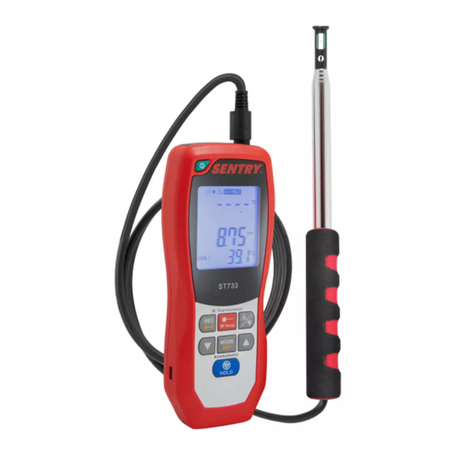
Sentry
Sentry ST730S instruction manual
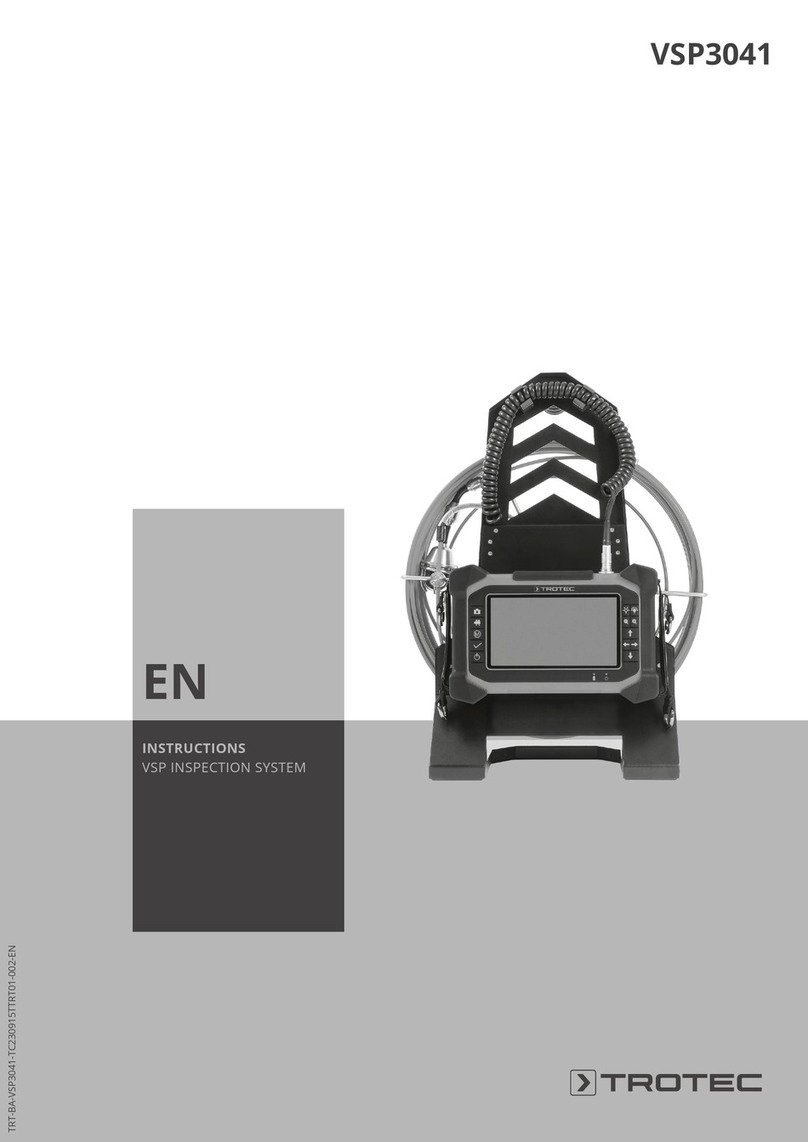
Trotec
Trotec VSP3041 instructions
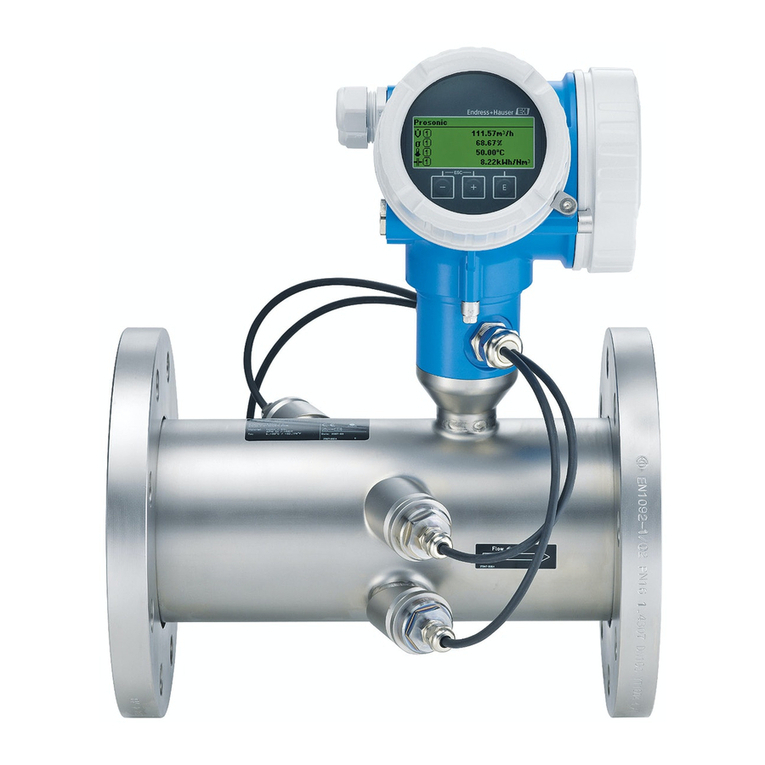
Endress+Hauser
Endress+Hauser Proline Prosonic Flow B 200 operating instructions
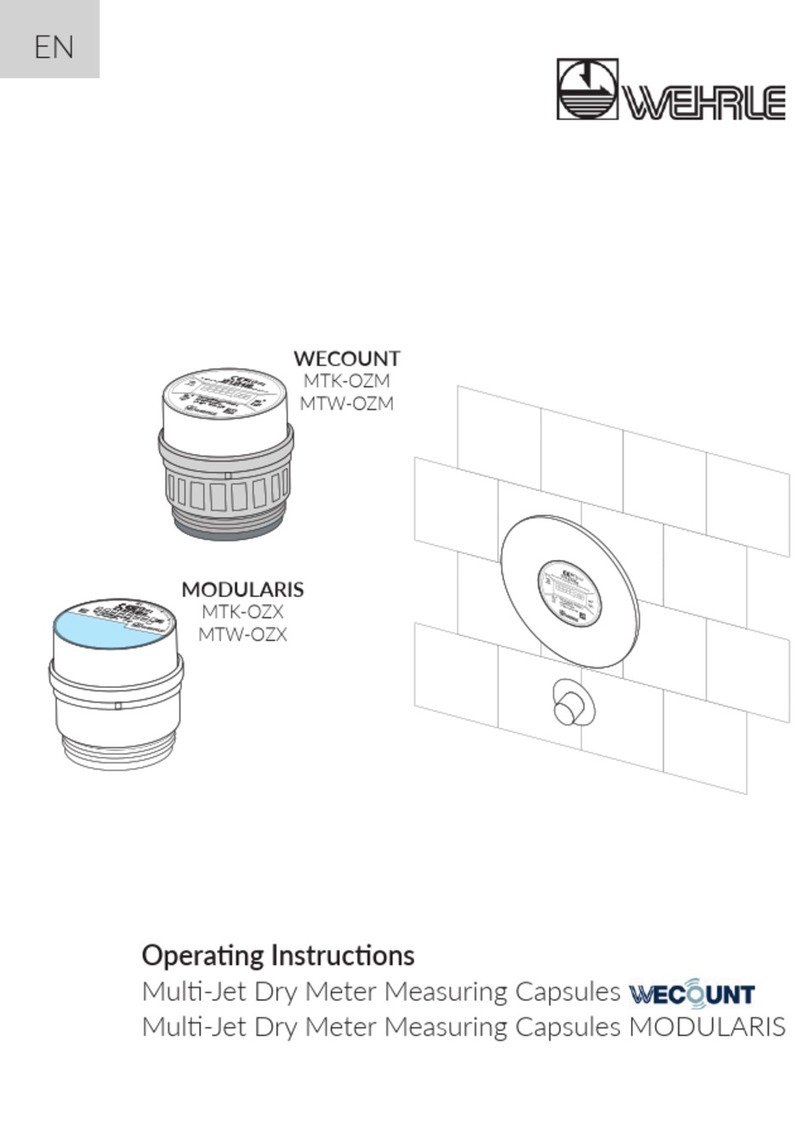
WEHRLE
WEHRLE WECOUNT MTK-OZM operating instructions
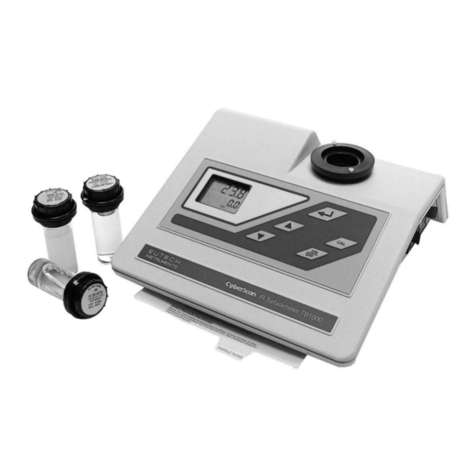
EUTECH INSTRUMENTS
EUTECH INSTRUMENTS CYBERSCAN TB 1000 TURBIDITY METER instruction manual
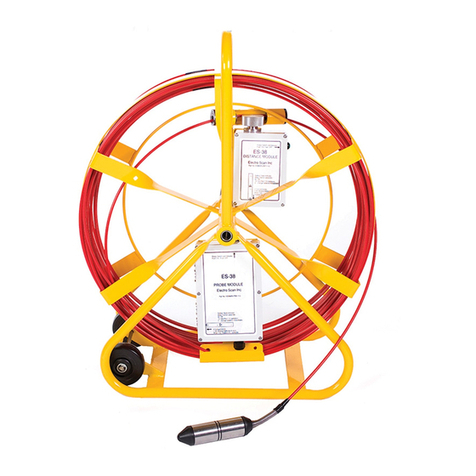
Electro Scan
Electro Scan ES-38 user guide
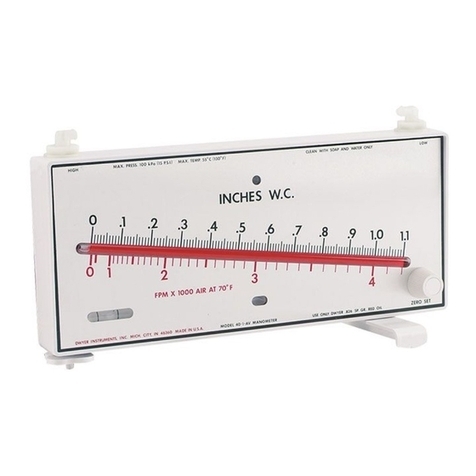
Dwyer Instruments
Dwyer Instruments Mark II 40 Series Installation and operating instructions
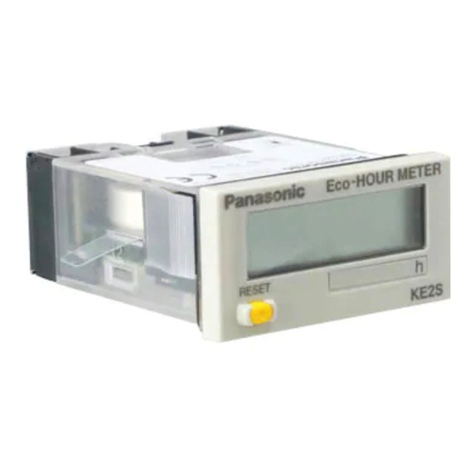
Panasonic
Panasonic KC2S Eco-COUNT METER manual
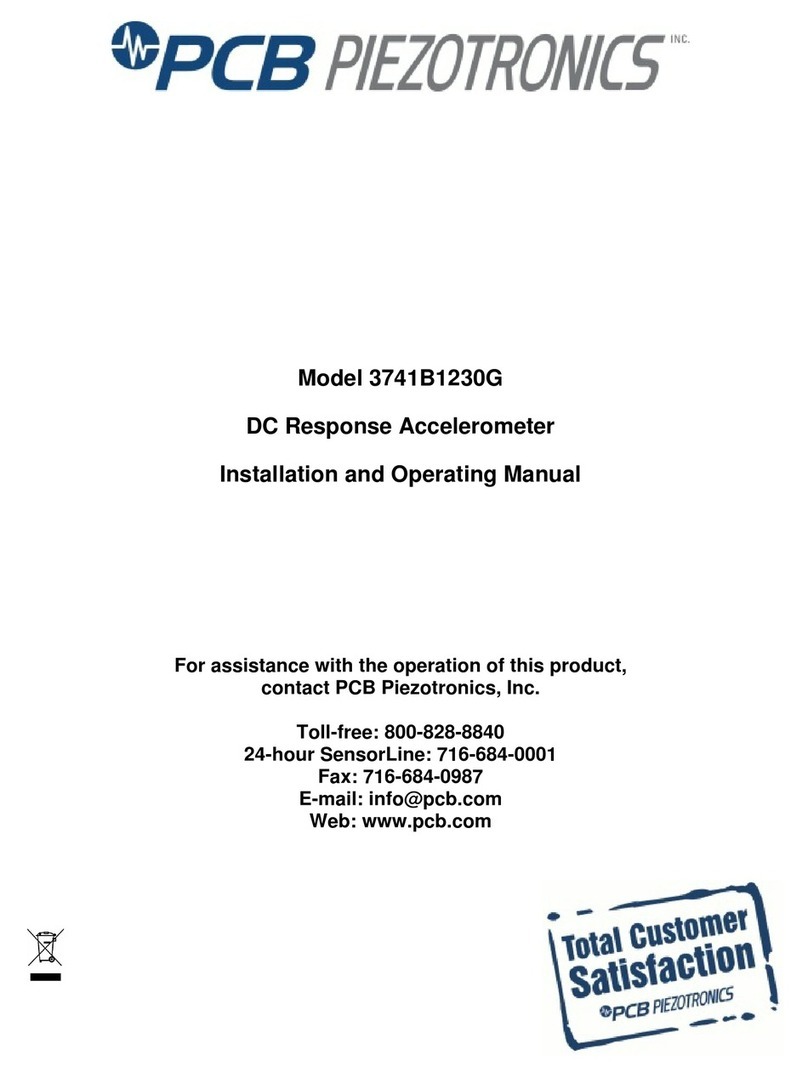
PCB Piezotronics
PCB Piezotronics 3741B1230G Installation and operating manual

Philips
Philips SmartSleep HH1607/02 manual

EXFO
EXFO IQ-5320 instruction manual

DIELEN
DIELEN VARIOMASS instruction manual

